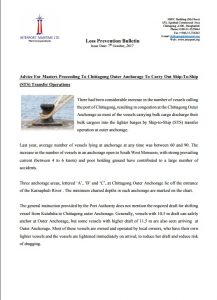|
Code:
151053
|
Swedish Club advises on STS operations at Chittagong

The Swedish P&I Club issued a bulletin, informing that there had been considerable increase in the number of vessels calling the port of Chittagong, resulting in congestion at the Chittagong Outer Anchorage. Most of the vessels carrying bulk cargo discharge cargoes into the lighter barges by Ship-to-Ship (STS) transfer operation at outer anchorage.
The increase in the number of vessels in an anchorage open to South West Monsoon, with strong prevailing current (between 4 to 6 knots) and poor holding ground have contributed to a large number of accidents, the Club said.
Most of the accidents have been caused due to the following reasons:
- Trying to cross the bow of an anchored vessel while maneuvering to drop anchor or while shifting anchor position;
- Arriving at Chittagong Outer Anchorage with excessive draft and inadequate under-keel clearance (UKC) resulting in dragging of anchor;
- Allowing too many lighter vessels alongside at one time resulting in increased drag and dragging of anchor;
- Allowing lighter vessels with inadequate fenders alongside;
- Failure to keep the engine ready for immediate maneuvering in case the anchor starts dragging
Recommendations
The Club provides the following guidance for Master’s anchoring at Chittagong Outer Anchorage:
- Anchor at a safe distance from other vessels at anchorage;
- If the UKC is less than two meters, there is a possibility that the vessel will drag anchor. The risk increases during spring tides and during monsoons. The tide can be strong as 6 to 7 knots per hour. The vessels draft should ideally be reduced to less than 10.5 m at Kutubdia before she arrives at Chittagong Outer Anchorage if safe conditions are to be maintained throughout. Risk of dragging is greatest when UKC is minimum and the tide changes from low water to high water and the risk persists until the vessel had been adequately lightened.
- For vessel’s lightering with lighter vessels’ alongside the chance of dragging anchor is even more. As a precaution vessels should use more chains (at least 9 shackles in the water), keep main engine on standby throughout and keep the number of lighter vessels’ alongside to minimum.
- When maneuvering for dropping anchor or for picking pilot vessels should never attempt to cross other vessel’s bow at a close range. Master should remember that the current is very strong and the vessel may ride on other’s cable.
- Deep draft vessels lightering at Alpha Anchorage should shift to Bravo or Charlie once they attain required draft to make room for safe anchoring of newly arrived deep draft vessel.
- Complete reliance on ECDIS is discouraged, cross check against up to date paper chart is advised.
- Ship’s Master are required to anchor clear off the prohibited anchorage.
- Ship’s Master must not anchor near the river entrance.
- Ship’s Master must maneouvre with great care when slowing down for embarking and/ disembarking pilot as the vessel at low speed may be overcome by the current and start to drift uncontrollably.
- Masters should ensure that the lighter vessels provided for STS operation have adequate fenders and moorings should be attended regularly. Lighter vessels should be cast off immediately if the weather deteriorates.
Explore more by reading the Club’s official bulletin:
















![AIRBUS A380 [MORE THAN 600 PASSENGER’S CAPACITY PLANE]](https://cdn.tinn.ir/thumbnail/4jCp4EQvCU0b/IjHVrSYQrIAqIzXuTzADR7qLYX4idQT4nfq__26E5SCUPLMqfhWkWajvuO9Wfq1ql1TjV4dhkrHliNQU82kMpo2NNftT_NGEwHc9KXtN_rk731bmifa2IQ,,/airbus-a380-structure1.jpg)

Send Comment